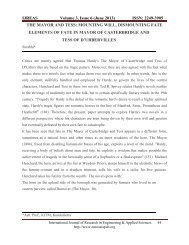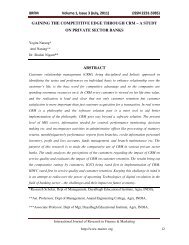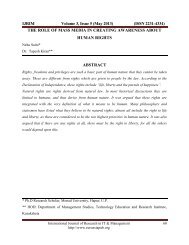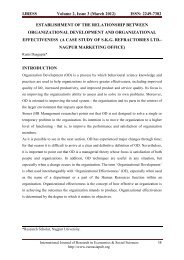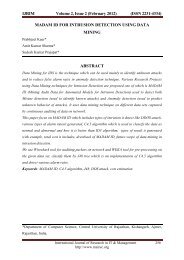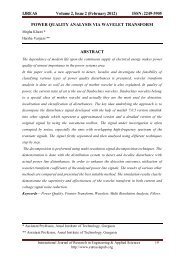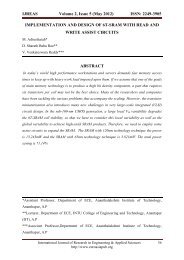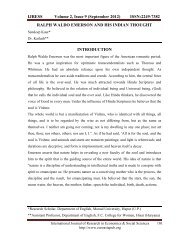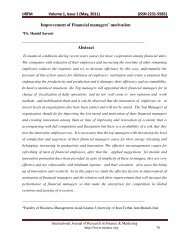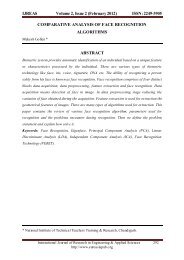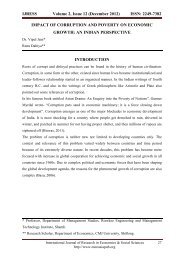scope of biodiesel in india - Euroasiapub.org
scope of biodiesel in india - Euroasiapub.org
scope of biodiesel in india - Euroasiapub.org
You also want an ePaper? Increase the reach of your titles
YUMPU automatically turns print PDFs into web optimized ePapers that Google loves.
IJREAS Volume 2, Issue 8 (August 2012) ISSN: 2249-3905<br />
that food crops may be displaced. However, the <strong>biodiesel</strong> sector <strong>in</strong> India is still <strong>in</strong> a nascent<br />
state, which is ma<strong>in</strong>ly due to a lack <strong>of</strong> economic viability for almost all activities related to<br />
the sector. Reasons for this general barrier to the development <strong>of</strong> <strong>biodiesel</strong> production <strong>in</strong><br />
India will be specified <strong>in</strong> Chapter 3.3. 3.1 The <strong>biodiesel</strong> value cha<strong>in</strong> <strong>in</strong> India The follow<strong>in</strong>g<br />
chapter describes some general aspects <strong>of</strong> the <strong>biodiesel</strong> value cha<strong>in</strong> <strong>in</strong> India. This will help to<br />
better understand and assess the developmental impacts <strong>of</strong> <strong>biodiesel</strong> production and<br />
consumption. For example, at the cultivation stage the type <strong>of</strong> land and type <strong>of</strong> plantation<br />
have important impacts on socioeconomic and environmental effects. Different ways <strong>of</strong><br />
process<strong>in</strong>g the raw material imply different cost structures and require different technical<br />
capacities. Not all <strong>of</strong> them are suitable for the same conditions. Different end-products are<br />
consumed by different people at different levels – local or more distant – and have different<br />
developmental impacts. Moreover, the use <strong>of</strong> by-products allows people to earn additional<br />
<strong>in</strong>come. As not all crops generate the same by-products, some crops may be more<br />
economically viable than others. The chapter is divided <strong>in</strong>to separate sections on the three<br />
steps <strong>of</strong> the value cha<strong>in</strong> – cultivation, process<strong>in</strong>g, and consumption – and a last section on<br />
different alternate uses and by-products <strong>of</strong> straight vegetable oil (SVO) and <strong>biodiesel</strong> that<br />
may generate additional <strong>in</strong>come sources. The follow<strong>in</strong>g figure presents the simplified value<br />
cha<strong>in</strong> <strong>of</strong> <strong>biodiesel</strong> <strong>in</strong> India. It breaks down <strong>in</strong>to three steps: cultivation, process<strong>in</strong>g, and<br />
consumption.<br />
Cultivation<br />
SVO, the raw material for <strong>biodiesel</strong>, can be extracted from many different plants. Seeds <strong>of</strong><br />
certa<strong>in</strong> plants (e.g. rapeseed, soya, sunflowers) have a high oil content and are, <strong>in</strong> some<br />
countries, used for <strong>biodiesel</strong> production. In India, SVO is derived almost exclusively from<br />
oil-bear<strong>in</strong>g trees. Several tree species can be selected for <strong>biodiesel</strong> production. More than 300<br />
different species <strong>of</strong> oil-bear<strong>in</strong>g trees exist <strong>in</strong> India. All <strong>of</strong> them are naturally grow<strong>in</strong>g wild<br />
species that have not yet been cultivated and harvested systematically for oil production on a<br />
larger scale.4 Some <strong>of</strong> the seeds have been traditionally collected by poor people for light<strong>in</strong>g.<br />
In small quantities, TBOs are used for commercial purposes <strong>in</strong> the pa<strong>in</strong>t, lubricant and soap<br />
<strong>in</strong>dustries. Accord<strong>in</strong>g to the National Oilseeds and Vegetable Oils Development Board <strong>of</strong> the<br />
Indian M<strong>in</strong>istry <strong>of</strong> Agriculture (NOVOD s.a.[d]) there are about ten species with economic<br />
potential for <strong>biodiesel</strong> production, <strong>in</strong>clud<strong>in</strong>g Jatropha curcas, Pongamia p<strong>in</strong>nata, Simarouba<br />
glauca,5 Azadirachta <strong>in</strong>dica (Neem) and Madhuca <strong>in</strong>dica (Mahua). Proponents <strong>of</strong> <strong>biodiesel</strong> <strong>in</strong><br />
India focus almost exclusively on Jatropha and to a lesser extent on Pongamia. Other species<br />
have not received much attention. The focus on Jatropha is justified ma<strong>in</strong>ly on the basis <strong>of</strong><br />
International Journal <strong>of</strong> Research <strong>in</strong> Eng<strong>in</strong>eer<strong>in</strong>g & Applied Sciences 4<br />
http://www.euroasiapub.<strong>org</strong>



